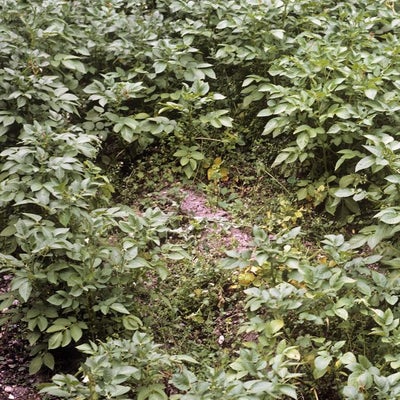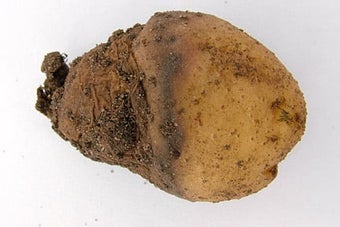
Quick facts
Common name - Golden or yellow cyst nematode and white cyst nematode
Scientific names - Globodera rostochiensis and G. pallida
Plants affected - Primarily potato but also other solanaceous plants (tomato, aubergine)
Main symptoms - Damage to the root system causing lack of vigour, poor yield, secondary rot
Caused by - Plant parasitic nematodes
What are potato cyst nematodes?
Nematodes are multicellular, unsegmented, worm-like animals. Potato cyst nematodes feed on the roots of potatoes and other solanaceous plants.
The Nematoda is a very diverse phylum of animals, there are more than 25 000 described species. Their adaptability to almost every habitat on earth including soil, freshwater, marine and all climatic zones is what makes them so successful. Nematodes are essential to ecosystems including the garden; a large proportion help break down and recycle organic material these are free-living nematodes other species are obligate parasites of plants and animals.
The two species of potato cyst nematodes that commonly occur in Britain are the golden or yellow cyst nematode (Globodera rostochiensis) and the white cyst nematode (G. pallida) which feed in the roots of potatoes and can cause the crop to fail. A cyst is the swollen female body (under 1 mm in diameter) that are filled with eggs. The cysts of the two species can be distinguished by its colour. The golden or yellow cyst nematode passes through a prolonged pale yellow phase, these can be seen if roots are examined with a hand lens when potatoes are ready for harvest. The cysts of the white cyst nematode change rapidly from creamy-white to brown.
Symptoms
Initially, crops display patches of poor growth and affected plants may show chlorosis and wilting, with poor top growth. These symptoms develop from the ground upwards.
If an affected plant is lifted carefully, it should be possible to see many pin head-sized spherical objects, known as cysts, on the roots. Nematode cysts are the dead bodies of females which can contain 200-600 eggs each. The cysts may be white, yellow or chestnut brown in colour and can be seen more readily with the aid of a hand lens.
Heavily infested plants die prematurely and yield a poor crop of under-sized tubers that often show signs of rotting. When an area is first infected by potato cyst nematode only a small part of it may be affected but in successive years the population will increase and spread through the movement of soil. The affected area will enlarge until it becomes impossible to grow worthwhile potatoes.
Wild plants of the Solanaceae family are rarely attacked and are of no importance as host plants in the UK although some, such as black nightshade (Solanum nigrum), will induce egg hatching from the cysts.
Life cycle
A) Cysts filled with hundreds of eggs are exposed to hatching factors, chemicals exuding from developing potato roots. B) Young nematodes called juveniles develop within each egg, the first moult happens inside the egg while the stylet forms. The stylet is the organ which will help to cut through the egg shell and will later be used to puncture plant cells for feeding. Second stage juveniles hatch from the eggs. C) They are microscopic worm-like creatures which enter the roots and feed internally on plant cell contents. Their feeding and development disrupt the uptake of water and nutrients. D) When almost mature, the female nematodes become globular in shape and burst through the root wall and are then fertilised by males. E) When the potatoes are harvested and pulled out of the soil the cyst are simultaneously pulled off and stays in the soil. F) The cysts will harden, dry and change colour. The cysts allow the succeeding generation to survive for an extended period of time in the soil until a suitable host plant is growing nearby. There is one generation a year on outdoor crops but two generations may be possible on glasshouse tomatoes.

Management
Cyst nematodes are persistent and difficult to control and although you may never eradicate them entirely from your soil, with care you should be able to minimise the worst of their effects.
Cultural methods should be used to avoid spreading the pest and to reduce populations.
Crop rotation
A high population of cysts may soon develop if potatoes or tomatoes are grown frequently in the same piece of soil. This can be avoided by adopting as long a rotation as possible (minimum of 5-6 years if you have a nematode problem). Alternative non host crops can safely be cultivated, during which time a combination of spontaneous hatch and natural mortality will reduce the population below damaging levels.
The increase in cyst numbers can also be limited by lifting a crop of potatoes as soon as the tubers are ready and not allowing the plants to continue growing beyond that point.
Self-set or 'volunteer' potatoes can maintain an infestation and so weed them out in early summer before the nematodes can complete their development. Nematode eggs can survive for up to ten years in some soils and so very long rotations are needed to starve out the nematodes completely. This process can be speeded up by sowing a half-hardy annual, sticky nightshade, Solanum sisymbriifolium. This plant’s roots induce egg hatching but nematodes cannot develop in the roots. Suppliers can be found via RHS Find a Plant.
Resistant varieties
There are some potato cultivars that have resistance to the golden cyst nematode (G. rostochiensis). These include;
Accent, Lady Christl, Pentland Javelin, Premiere, Rocket, Winston (earlies), Blue Danube, Kestrel, Nadine, Saxon (second earlies), Cara, Maris Piper, Maxine, Nicola, Picasso, Sante, Stemster, Valor (maincrop)
The root exudates produced by these cultivars still induce egg hatching and the roots are attacked in the usual way. Females, however, are unable to develop inside the roots and only males are produced, thus reducing the number of eggs in the soil. White cyst eelworms can reproduce normally on these varieties. Crop rotation is still important, even in areas where the golden cyst nematode predominates, as there is a danger that the other species may also be present and will increase in numbers if potatoes are grown too frequently.
Some cultivars also have some tolerance of white cyst nematode (G. pallida), in addition to resistance to golden cyst nematode. These include;
Harmony, Kestrel, Lady Balfour, Maxine, Sante, Valor
The white cyst eelworm is able to complete its normal life cycle and reproduce in the roots of these varieties, but they are nevertheless able to produce a worthwhile crop, provided the soil is not heavily infested.
You can compare resistance levels of different potato varieties on the British Potato Variety Database.
Hygiene and waste disposal
Once soil becomes infested with cysts it is difficult to prevent them being spread around the garden, steps should be taken to avoid this. Sanitise all equipment and shoes that came in contact with the infested soil, dig out roots and unwanted plants from the affected plots but remember not to put them on the heap and dispose of as diseased material.
Soil that has grown potatoes should never be used in the greenhouse for growing tomatoes. If greenhouse beds have populations of potato cyst nematose then the problem can be overcome by complete re-soiling, or by growing tomatoes in raised beds, growbags, or other systems, such as ring culture, or straw bales, which reduce root contact with the infested soil.







